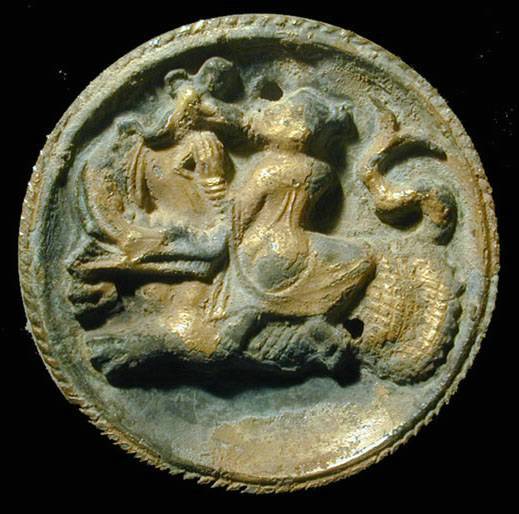

A small Greek-influenced "palette" or tray to hold cosmetics or unguents, Gandhara, c.1st c. BCE
Source: http://www.vcoins.com/ancient/frankkovacs/store/viewItem.asp?idProduct=316&large=1
(downloaded Oct. 2006)
"Gandharan gilt bronze palette. c.1st cent. BC. The relief scene on this palette shows a sea goddess (Nereid) riding a sea monster (ketos), and reaching out to a winged Eros/putto. 10 cm diameter (4 inches). Complete except for a small hole in the blank area of the background, and a small hole on the fore-flipper and hindquarters of the monster, and a crack on the backing plate. About half of the gilding on the front remains. (The somewhat patchy appearance is due to some surface dirt and encrustations which have not yet been removed, since it should be done by a professional conservator.)This is a fine and possibly unique example of a classic Gandharan art form. Small palettes or trays with similar relief figures are characteristic products of the north-west borderlands between Pakistan and Afghanistan, particularly the Taxila area. The known examples, however, are made of stone while the present one is bronze which was originally entirely covered with gilding, front and back. Further, the relief scene is not repousse from a sheet of bronze, but seems to have been cast(?) separately (or outline-cut from a thick sheet of repousse bronze?) and soldered onto the concave palette; in a few places one can see the edge of the figure pulling up from the dish's surface. This technique of manufacture is otherwise unparalleled.
The type, palettes with areas for cosmetics or ungents, demonstrate the transition from Hellenistic style and forms to the Indian, and the reinterpretation of Greek motifs to Eastern context. The palette was invented in early Hellenistic Anatolia or Alexandria, decorated generally with busts of gods. The earliest palettes in the east carry subjects from Greek mythology, only slightly indianized in the physique of the women and their jewellery. The favorite subject was the sea monter ketos alone, or ridden by a male or female, or Eros/putto. An early stone palette in the Taxila Museum has a scene identical to the present bronze palette (but much cruder art): a sea goddess (Nereid) riding a sea monster with a crocodile-like snout, reaching up for the Eros/putto on the monster's neck. It has been argued recently that this motif may have been popular in the Indo-Scythian area because it could be associated with the Saka/Scythian royal mythology concerning a female aquatic deity with royal implications. For the iconography of the ketos see Boardman, in LIMC VIII,731-736. For some stone palettes see Boardman in Crossroads of Asia (1992): 152-8. For the connection with Saka royal mythology see Martha Carter in Bulletin of the Asia Institute 6 (1992): 67-78, esp. 72-3."
== Indian Routes index == Indian Routes sitemap == Glossary == FWP's main page ==